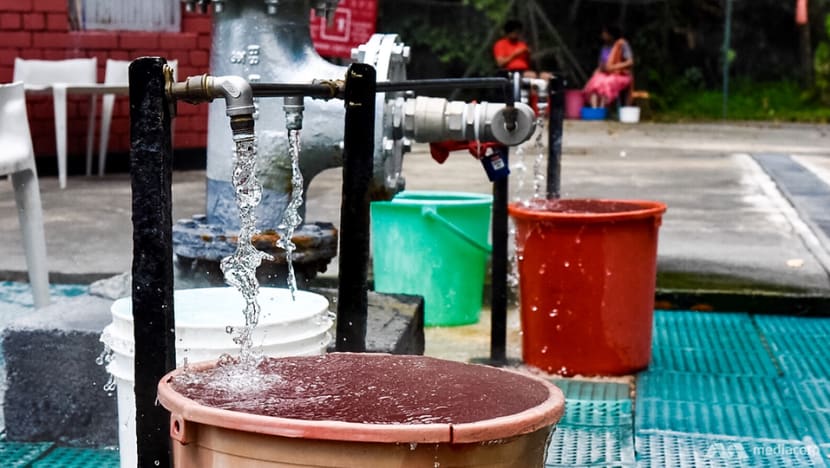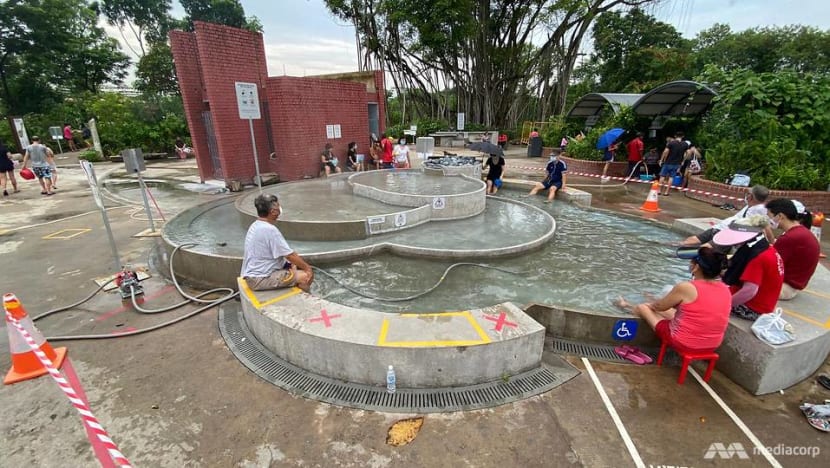Scientists dig deep into ‘promising’ geothermal energy resource near Sembawang hot spring
Researchers said the findings are a significant breakthrough as they could provide a valuable non-fossil fuel option for energy in resource-scarce Singapore.

The only natural hot spring on the main island of Singapore, located at Sembawang. (Photo: Justin Ong)
SINGAPORE: Researchers are exploring a geothermal resource in Singapore that could be a potential site for a consistent source of clean energy.
Hot temperatures found deep underground at a site near the Sembawang hot spring could possibly generate enough energy to power cooling systems, scientists behind the research said.
They drilled a 1.1km hole into the ground at Admiralty Lane, and discovered the average temperature of the Simpang granite found at that depth hot enough to cook a soft-boiled egg.
The study said the heat is higher than rock temperatures found at the same depth in many other non-volcanic regions in the world.
HOW DEEP TO DIG?
Researchers analysed rock temperatures at different depths, and estimated the geothermal site could have a temperature of 200 degrees Celsius or more at depths of 4km to 5km and deeper.
“This is an initial step towards ascertaining and assessing whether geothermal could really be made available for Singapore,” said Associate Professor Alessandro Romagnoli, who co-led the research team.
Prof Romagnoli, who is the cluster director of multi-energy systems and grids at Nanyang Technological University’s (NTU) Energy Research Institute, said researchers first explored surface features at hot springs in Sembawang and Pulau Tekong.
Previous studies had indicated potential hot temperatures at relatively shallow depths, he added.

“As we drill deeper, we will find higher temperatures. The question is, at what depth we can identify temperatures high enough that can be made available for extraction and utilisation?
“Looking at current heat extraction and utilisation technologies, a 4km to 5km depth is considered somewhat viable,” Prof Romagnoli told CNA’s Singapore Tonight on Tuesday (Jul 18).
The team conducting the study is from NTU and TUMCREATE, the Technical University of Munich’s multidisciplinary research platform in Singapore, alongside infrastructure consultancy Surbana Jurong.
CLEAN ENERGY SOURCE
Researchers said the “promising findings” are a significant breakthrough as they could provide a valuable non-fossil fuel option for energy in resource-scarce Singapore.
Solar power is the most viable renewable energy source for the nation, but geothermal could fill some gaps that solar poses, they said.
“Geothermal energy has quite a lot of advantages over photovoltaic (PV). For instance, it provides continuous and constant energy. It is not subject to fluctuations,” said principal scientist Tobias Massier from TUMCREATE.
Photovoltaic technology is dependent on direct sunlight, which it converts into electrical energy, a process commonly known as solar power.
“Also, geothermal can do so much more compared to photovoltaics. You can only produce electricity with photovoltaics, but with geothermal energy, you have a lot more applications,” said Dr Massier.
WHAT CAN GEOTHERMAL ENERGY DO?
With geothermal energy, electricity generation could be possible at 150 degrees Celsius, while even higher temperatures could produce hydrogen, he said.
The resource can also be used for multiple outputs.
“We could start at a high temperature and generate electricity, then the outcome of that process is a lower temperature of the geothermal fluid, which we then produce energy for cooling,” he said.
As the temperature lowers after each use, the fluid could be rerouted for other purposes such as desalination and even recreational activities like spas.
Geothermal energy has a particularly high potential for cooling systems, Dr Massier said.
“Currently we use natural gas, burn it, convert it to electricity, and then convert it to cool air. That's basically what happens in an air conditioner.
“With geothermal power, we could use the heat that we get directly immediately for cooling, which would have a much higher efficiency. With this, we could really cover quite a bit of the cooling demand here in Singapore,” he explained.
ENERGY SECURITY & RESILIENCE
With a growing population and infrastructure demand that guzzles energy such as data centres, this renewable resource is of significant importance in potentially alleviating Singapore's energy challenges, said the researchers.
Should the capacity of geothermal energy available be determined to be substantial, the nation could have a clean energy source over the next few decades, said Prof Romagnoli.
While challenges remain in the development of deep drilling technologies and the extraction of geothermal energy at a commercial scale, he is optimistic that harvesting the resource could be made possible soon.
“Looking at the pace of development of technologies worldwide, that gives us an optimistic perspective that geothermal could potentially be utilised in Singapore over this decade or the next,” he said.
“Singapore’s renewable landscape is linked to solar, so having geothermal could be a very interesting additional element to enhance the energy mix and to provide energy security and resilience to the country.”
















